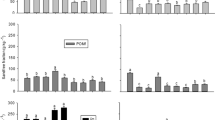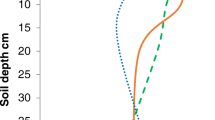Abstract
Agroforestry systems (AFSs) have an important role in capturing above and below ground soil carbon and play a dominant role in mitigation of atmospheric CO2. Attempts has been made here to identify soil organic matter fractions in the cacao-AFSs that have different susceptibility to microbial decomposition and further represent the basis of understanding soil C dynamics. The objective of this study was to characterize the organic matter density fractions and soil size fractions in soils of two types of cacao agroforestry systems and to compare with an adjacent natural forest in Bahia, Brazil. The land-use systems studied were: (1) a 30-year-old stand of natural forest with cacao (cacao cabruca), (2) a 30-year-old stand of cacao with Erythrina glauca as shade trees (cacao + erythrina), and (3) an adjacent natural forest without cacao. Soil samples were collected from 0-10 cm depth layer in reddish-yellow Oxisols. Soil samples was separated by wet sieving into five fraction-size classes (>2000 μm, 1000–2000 μm, 250–1000 μm, 53–250 μm, and <53 μm). C and N accumulated in to the light (free- and intra-aggregate density fractions) and heavy fractions of whole soil and soil size fraction were determined. Soil size fraction obtained in cacao AFS soils consisted mainly (65 %) of mega-aggregates (>2000 μm) mixed with macroaggregates (32–34%), and microaggregates (1–1.3%). Soil organic carbon (SOC) and total N content increased with increasing soil size fraction in all land-use systems. Organic C-to-total N ratio was higher in the macroaggregate than in the microaggregate. In general, in natural forest and cacao cabruca the contribution of C and N in the light and heavy fractions was similar. However, in cacao + erythrina the heavy fraction was the most common and contributed 67% of C and 63% of N. Finding of this study shows that the majority of C and N in all three systems studied are found in macroaggregates, particularly in the 250–1000 μm size aggregate class. The heavy fraction was the most common organic matter fraction in these soils. Thus, in mature cacao AFS on highly weathered soils the main mechanisms of C stabilization could be the physical protection within macroaggregate structures thereby minimizing the impact of conversion of forest to cacao AFS.
Similar content being viewed by others
References
Bronick CJ, Lal R (2005) Soil structure and management: a review. Geoderma 124:3–22
Cadish G, Mutuo P, Mercado A, Hairiah K, Nyamugafata P, Boye A, Albrecht A (2006) Organic matter management in tropical agroforestry systems: soil quality, soil C storage and soil atmosphere gas exchange. In: Gama-Rodrigues AC, Barros NF, Gama-Rodrigues EF, Freitas MSM, Viana AP, Jasmin JM, Marciano CR, Carneiro JGA (eds) Sistemas Agroflorestais: Bases Científicas para o desenvolvimento sustentável. UENF, Campos dos Goytacazes, RJ, pp 275–290
Cambardella CA, Elliot ET (1994) Carbon and nitrogen dynamics of soil organic matter fractions from cultivated grassland soils. Soil Science Society of America Journal 58:123–130
Castro Filho C, Lourenço A, Guimarães MF, Fonseca ICB (2002) Aggregate stability under different management systems in a red Latosol in the State of Paraná, Brasil. Soil Tillage Research 65:45–51
Chan KY, Heenan DP (1996) The influence of crop rotation on soil structure and soil physical properties under conventional tillage. Soil Tillage Research 37:113–125
Christensen BT (1992) Physical fractionation of soil and organic matter in primary particle size and density separates. Advances in Soil Sciences 20:1–90
Christensen BT (2000) Organic matter in soil—structure, function and turnover. DIAS Report No. 30, Tjele, Plant Production
Elliott ET, Coleman DC (1988) Let the soil work for us. Ecological Bulletins 39:23–32
Freixo AA, Machado PLOA, Santos HP, Silva CA, Fadigas FS (2002) Soil organic carbon and fractions of a Rhodic Ferralsol under the influence of tillage and crop rotation systems in southern Brazil. Soil Tillage Research 64:221–230
Funarbe (2007) SAEG—Sistema para análise estatística e geográfica 5.0.Viçosa, MG
Gama-Rodrigues AC, Cadima-Zevallos A (1991) Efectos de fertilización sobre sistema radicular de cacao en suelos de “tabuleiros” del sur de Bahia, Brasil. Turrialba 41:135–141
Gama-Rodrigues EF, Nair PKR, Nair VD, Gama-Rodrigues AC, Baligar V, Machado RCR (2010) Carbon storage in soil size fractions under two cacao agroforestry systems in Bahia, Brazil. Environmental Management 45:274–283
Golchin A, Oades JM, Skjemstad JO, Clarke P (1995) Structure and dynamic properties of soil organic matter reflected by 13C natural abundance, pyrolysis mass spectrometry and solid-state 13C NMR spectroscopy in density fractions of an Oxisol under forest and pasture. Australian Journal Soil Research 33:59–76
Golchin A, Baldock JA, Oades JM (1997) A model linking organic matter decomposition, chemistry, and agregate dynamics. In: Lal R, Kimble J M, Follet R F, Stewart B A (ed) Soil processes and the carbon cycle. CRC Press, Boca Raton: pp 245-266 (Advances in Soil Science)
Gupta VVSR, Germida JJ (1988) Distribution of microbial biomass and its activity in different soil aggregate size classes as affected by cultivation. Soil Biology & Biochemistry 20:777–786
Gupta N, Kukal SS, Bawa SS, Dhaliwal GS (2009) Soil organic carbon and aggregation under poplar based agroforestry system in relation to tree age and soil type. Agroforestry Systems 76:27–35
Haile SG, Nair PKR, Nair VD (2008) Carbon storage of different soil-size fractions in Florida silvopastoral systems. Journal of Environmental Quality 37:1789–1797
Hassink J (1995) Density fractions of soil macroorganic matter and microbial biomass as predictors of C and N mineralization. Soil Biology & Biochemistry 27:1099–1108
Haynes RJ, Beare MH (1997) Influence of six crop species on aggregate stability and some labile organic matter fractions. Soil Biology & Biochemistry 29:1647–1653
IPCC (2000) Land use, land-use change and forestry. A special report of the IPCC. Cambridge University Press, Cambridge, UK
Isaac ME, Gordon AM, Thevathasan N, Oppong SK, Quashie-Sam J (2005) Temporal changes in soil carbon and nitrogen in West African multistrata agroforestry systems: a chronosequence of pools and fluxes. Agroforestry Systems 65:23–31
Jin X, Wang S, Zhou Y (2008) Dynamic of organic matter in the heavy fraction after abandonment of cultivated wetlands. Biology & Fertility of Soils 44:997–1001
John B, Yamashita T, Ludwig B, Flessa H (2005) Storage of organic carbon in aggregate and density fractions of silty soils in different types of land use. Geoderma 128:63–79
Kummerow J, Kummerow M, Silva WS (1982) Fine-root growth dynamics in cacao (Theobroma cacao). Plant Soil 65:193–201
Lal R (2004) Soil carbon sequestration impacts on global climate change and food security. Science 304:1623–1627
Lal R, Griffin M, Apt J, Lave L, Morgan MG (2004) Managing soil carbon. Science 304:393
Lal R, Cerri CC, Bernoux M, Etchevers J, Cerri E (eds) (2006) Carbon sequestration in soils of Latin America. Food Products Press, New York
Liao JD, Boutton TW, Jastrow JD (2006) Storage and dynamics of carbon and nitrogen in soil physical fractions following woody plant invasion of grassland. Soil Biology & Biochemistry 38:3184–3196
Lugo AE, Cuevas E, Sanchez MJ (1990) Nutrients and mass in litter and soil of ten tropical tree plantations. Plant Soil 125:263–280
Macedo MO, Resende AS, Garcia PC, Boddey RM, Jantalia CP, Urquiaga S, Campello EFC, Franco AA (2008) Changes in soil C and N stocks and nutrient dynamics 13 years after recovery of degraded land using leguminous nitrogen-fixing trees. Forest Ecology Management 255:1516–1524
Madari B, Machado PLOA, Torres E, Andrade AG, Valencia LIO (2005) No tillage and crop rotation effects on soil aggregation and organic carbon in a Rhodic Ferralsol from southern Brazil. Soil Tillage Research 80:185–200
Montagnini F, Nair PKR (2004) Carbon sequestration: an inexploited environmental Benedit of agroforestry systems. Agroforestry Systems 61:281–295
Müller MW, Gama-Rodrigues AC (2007) Sistemas Agroflorestais com cacaueiro. In: Valle RR (ed) Ciência. Tecnologia e Manejo do Cacaueiro. CEPLAC, Ilhéus, BA, Brazil, pp 246–271
Nair PKR, Kumar BM, Nair VD (2009) Agroforestry as a strategy for carbon sequestration. Journal of Plant Nutrition and Soil Science 172:10–23
Oades JM (1984) Soil organic matter and structural stability: mechanisms and implications for management. Plant Soil 76:319–337
Oades JM (1988) The retention of organic matter in soils. Biogeochemistry 5:35–40
Oades JM, Waters AG (1991) Aggregate hierarchy in soils. Australian Journal Soil Research 29:815–828
Oades JM, Vassalo AM, waters AG, Wilson MA (1987) Characterization of organic matter in particle size and density fractions from Red-Brown Earth by solid-state 13C NMR. Australian Journal Soil Research 25:71–82
Poirier N, Sohi SP, Gaunt JL, Mahieu N, Randall EW, Powlson DS, Evershed RP (2005) The chemical composition of measurable soil organic matter pools. Organic Geochemistry 36:1174–1189
Resende M, Curi N, Rezende SB, Correa GF (1997) Pedologia: base para a descrição de ambientes, 2nd edn. NEPUT, Viçosa
Roscoe R, Buurman P (2003) Tillage effects on soil organic matter in density fractions of a Cerrado Oxisol. Soil Tillage Research 70:107–119
Schwendenmann L, Pendall E (2006) Effects of forest conversion into grassland on soil aggregate structure and carbon storage in Panama: evidence from soil carbon fractionation and stable isotopes. Plant Soil 288:217–232
Six J, Elliot ET, Paustian K, Doran JW (1998) Aggregation and soil organic matter accumulation in cultivated and native grassland soils. Soil Science Society of America Journal 63:1350–1358
Six J, Elliot ET, Paustian K (1999) Aggregate and soil organic matter dynamics under conventional and no tillage systems. Soil Science Society of America Journal 63:1350–1358
Six J, Elliot ET, Paustian K (2000) Sol macroaggregate turnover and microaggregate formation: a mechanism for C sequestration under no-tillage agriculture. Soil Biology & Biochemistry 32:2099–2103
Sohi S, Mahieu N, Arah JRM, Powlson DSP, Madari B, Gaunt JL (2001) Procedure for isolllating soil organic matter fractions suitable for modelling. Soil Science Society of America Journal 65:1121–1128
Sollins P, Homann P, Caldwell BA (1996) Stabilization and destabilization of soil organic matter: mechanisms and controls. Geoderma 74:65–105
Stevenson FJ (1994) Humus chemistry: genesis composition reactions. Wiley, New York
Takimoto A, Nair VD, Nair PKR (2009) Contribution of trees to soil carbon sequestration under agroforestry systems in the West African Sahel. Agroforestry Systems 76:11–25
Tan Z, Lal R, Owens L, Izaurralde RC (2007) Distribution of Light and heavy fractions of soil organic carbon as related to land use and tillage practice. Soil Tillage Research 92:53–59
Tisdall JM, Oades JM (1982) Organic matter and water-stable aggregates in soils. Journal of Soil Science 33:141–163
Ussiri DAN, Johnson CE (2007) Organic matter composition and dynamics in a northern hardwood forest ecosystem 15 years after clear cutting. Forest Ecology Management 240:131–142
Yamashita T, Flessa H, John B, Helfrich M, Ludwig B (2006) Organic matter in density fractions of water-stable aggregates in silty soils: effect of land use. Soil Biology & Biochemistry 38:3222–3234
Yin YF, Cai ZC, Lu JL (2005) Relationship between light and heavy fractions of organic matter for several agricultural soils in China. Journal of Environmental Sciences 17:917–920
Zhang J, Song C, Wenyan Y (2007) Tillage effects on soil carbon fractions in the Sanjiang Plain Northeast China. Soil Tillage Research 93:102–108
Zotarelli L, Alves BJR, Urquiaga S, Torres E, Santos HP, Paustian K, Boddey RM, Six J (2005) Impact of tillage and crop rotation on aggregate-associated carbon in two Oxisols. Soil Tillage Research 95:196–206
Zotarelli L, Alves BJR, Urquiaga S, Boddey RM, Six J (2007) Impact of tillage and crop rotation on light fraction and intra-aggregate soil organic matter in two Oxisols. Soil Science Society of America Journal 69:482–491
Acknowledgments
The authors would like to acknowledge “Pau Brasil Foundation” for the first author’s fellowship; Dr. Michele Oliveira Macedo (In memorian) and Dr. David Campos for technical support in density fractionation method; Kátia R. Nascimento Sales for technical support in soil analysis within the Soil Laboratory at North Fluminense State University; and Volney Magalhães for technical assistance in collecting soil samples.
Author information
Authors and Affiliations
Corresponding author
Rights and permissions
About this article
Cite this article
Rita, J.C.O., Gama-Rodrigues, E.F., Gama-Rodrigues, A.C. et al. C and N Content in Density Fractions of Whole Soil and Soil Size Fraction Under Cacao Agroforestry Systems and Natural Forest in Bahia, Brazil. Environmental Management 48, 134–141 (2011). https://doi.org/10.1007/s00267-011-9642-3
Received:
Accepted:
Published:
Issue Date:
DOI: https://doi.org/10.1007/s00267-011-9642-3




